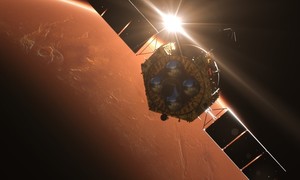![An image of Chinese Mars probe Tenwon 1 that successfully entered Mars orbit on the 5th.[사진= 글로벌타임즈 갈무리]](https://i0.wp.com/cdn.hellodd.com/news/photo/202102/91717_303094_493.jpeg?w=560&ssl=1)
It is the time of the Mars exploration Renaissance. On the morning of the 10th (Korean time), the Mars probe from the UAE (United Arab Emirates) successfully entered orbit, and the same afternoon, the Chinese Mars probe’Tenwon 1’successfully entered Mars orbit. The US Mars probe is about to enter Mars orbit on the 18th.
According to the China National Space Agency (CNSA), Tenwon 1 entered Mars orbit on the afternoon of the 10th. It is the sixth time after the US, Russia, the European Space Agency (ESA), India, and the UAE.
Tenwon 1 consists of an orbiter, a lander, and an exploration rover. It is currently orbiting 400 km from Mars. Tenwon 1 is scheduled to land on the Hwaseong surface from May to June. If China succeeds in landing, it will become the third landing country on Mars after the United States and Russia. In addition, China will be the first country on Mars to operate orbiters, landers, and exploration robots simultaneously.
According to CNSA, Tenwon 1 will orbit Mars for three months and deploy a lander and rover to land south of the Utopia Plain of Hwaseong by May. Tenwon 1 will stay on the surface of Mars for 90 days after landing, collect samples of the surface and bring it to Earth. In particular, they specifically search for the existence of water and ice.
Tenwon 1 also sent a picture of Mars’ appearance taken from a distance of about 220 km from Mars on the 5th to Earth.
![An image of the US rover Percivirence exploration on Mars.[사진= NASA 갈무리]](https://i0.wp.com/cdn.hellodd.com/news/photo/202102/91717_303095_5018.jpg?w=560&ssl=1)
The US Mars exploration rover’Percivirence’ is expected to arrive in Mars orbit around the 18th. Percivience is the fifth US probe to Mars. The goal is to reveal the existence of life on Mars, the ancient environment of Mars, and the history of the Mars index.
The National Aeronautics and Space Administration (NASA) has announced plans for Mars 2020, including Percivirance and Mars Helicopter Ingenuity, and is speeding up exploration to Mars. Mars Helicopter’Ingenuity’ will instead explore cliffs or gorges that are difficult to access.
About 60 pieces of equipment are loaded in the Mars 2020. The X-ray spectrometer FLXL to analyze Martian soil and the underground mass analysis radar RIMRAX were installed. It searches for the constituents and water in the basement of Mars within 10m. It includes equipment that can measure the temperature, wind speed, air pressure, and dust on Mars, as well as equipment that detects minerals, oxygen, carbon, and nitrogen. Sherlock (SHERLOC) analyzes ultraviolet rays and finds a good place for humans to live.
MOXIE equipment is also installed. It is a device that converts the atmosphere of Mars made of carbon dioxide into oxygen. It was produced by MIT and the University of Copenhagen, and the Niels Bohr Institute was also involved. Humans breathe on Mars’ surface and play a role in the production of oxygen for rocket propellants. In addition, a SuperCam is installed, allowing scientists to analyze the characteristics of the rock and hear the sound of Martian wind. It is a probe where science and technology for mankind’s advance into space are gathered.
![The surface of Mars photographed by the European Space Agency's CaSSIS camera on the Exomas gas tracking orbiter.[사진= BBC 갈무리]](https://i0.wp.com/cdn.hellodd.com/news/photo/202102/91717_303097_5753.jpg?w=560&ssl=1)
The European Space Agency also released a picture of Mars on the 13th (local time). The pictures of Mars, released through BBC reports, were taken by the European Space Agency’s Exomas Tracking Orbiter (TGO). The European Space Agency used a CaSSIS (Colour and Stereo Surface Imaging System) camera on the Exomas mission to observe geological features such as minerals, canyons, and craters.
According to the BBC, CaSSIS shot more than 300 images per week. It flies at a speed of about 3km/s and shoots fast. According to Professor Nicholas Thomas, you get about 4.5m per pixel on a surface at a distance of about 400km, the same as looking at a bus in London from Liverpool.
“We used CasSIS to get more information,” said Nicholas Thomas, a professor at the University of Bern, Switzerland, who produced CaSSIS. “The ability to see sediments in some areas is also very interesting.” TGO entered Mars orbit on 19/19/2016 and made a map of the distribution of various gases, including methane gas on Mars.
As each nation’s Mars probes deliver news of the orbital entry and arrival of Mars one after another, the expectation of humanity’s advance to Mars is also rising. Private companies are also actively investing in space development. If the history of Mars, the existence of living organisms, and the composition of the planet are confirmed, it is expected that the Mars capital of humanity will not be far away. It is expected that domestic cooperation will also accelerate with the private sector.
![Mars sediments.[사진= BBC 갈무리]](https://i0.wp.com/cdn.hellodd.com/news/photo/202102/91717_303098_5758.jpg?w=560&ssl=1)
![Mars surface.[사진= BBC 갈무리]](https://i0.wp.com/cdn.hellodd.com/news/photo/202102/91717_303096_5748.jpg?w=560&ssl=1)
![Carbon dioxide frozen on the surface of Mars' high latitudes.[사진= BBC 갈무리]](https://i0.wp.com/cdn.hellodd.com/news/photo/202102/91717_303099_5828.png?w=560&ssl=1)
Send SNS article
